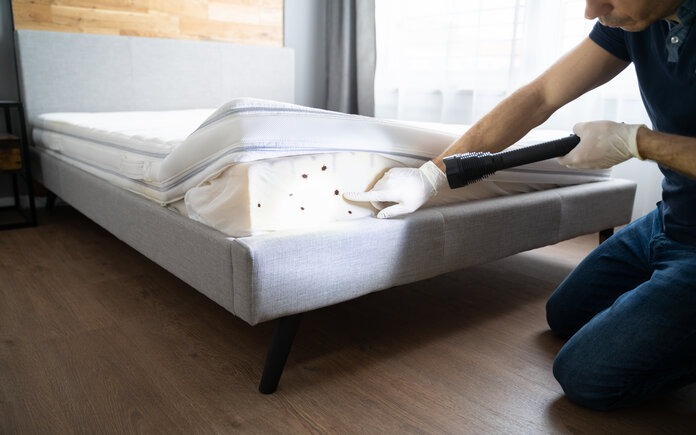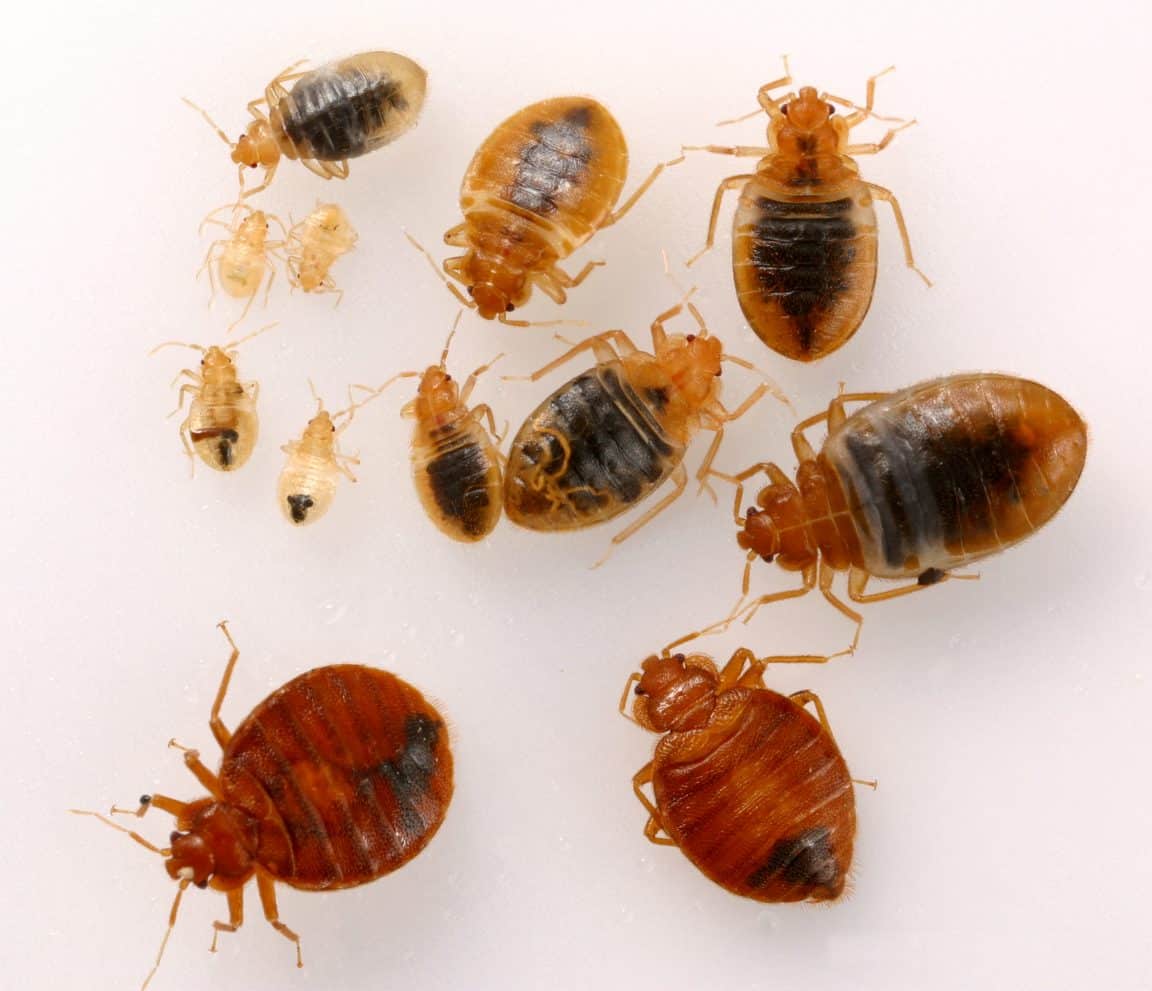Don’t let bed bugs disrupt your sleep (and leave you with painfully itchy red bumps). Over the years, as a pest control specialist, bed bugs have been at the top of the list of bugs that homeowner’s I’ve helped regret failing to take action on sooner. If you suspect a bed bug infestation, it’s advisable to consult a professional pest control company for effective eradication and peace of mind.
In your quest to address bed bug infestations, professional assistance is crucial. That’s why we’ve carefully selected Terminix and Orkin as our top national pest control picks that effectively eliminate bed bugs. With their expertise and specialized treatments, these trusted providers help you regain control of your home and ensure a bed-bug-free environment.
What Do Bed Bugs Look Like?

Bed bugs are small, reddish-brown insects with oval-shaped bodies. Between the size of fleas and cockroaches, they measure around 4 to 5 millimeters in length and have a flat appearance.
However, after feeding on blood, their bodies swell, turning elongated and redder in color. Adult bed bugs have six legs, two antennae, and no wings. They possess a segmented body with a distinct head, abdomen, and short hairs covering their bodies. Their mouthpart, known as a proboscis, is beak-like and used for piercing the skin to feed.
Bed bug eggs are hard to see, measuring just 1 millimeter in length. They’re white and often clustered in hidden areas like mattress seams, furniture crevices, or wall cracks. Nymphs, or young bed bugs, resemble smaller versions of adults but are lighter to translucent in color. They undergo several molting stages before reaching adulthood.
How Do You Identify Bed Bug Bites?

Bed bug bites vary in appearance from person to person. They typically appear as small, red, itchy bumps (similar to flea bites). Often, bed bugs look like clusters or hives or may even appear as small welts in a line, in areas exposed during sleep, such as the arms, shoulders, neck, or legs.
Some individuals are allergic to bed bug bites, resulting in more severe symptoms such as intense itching, swelling, and blisters.
Bed bug bites are no joke. While most bed bug bites heal within a week or two, some individuals experience more severe reactions or develop secondary infections from scratching. If you suspect bed bugs have bitten you and experience persistent symptoms, or if you notice signs of an allergic reaction, it’s time to see your doctor for proper treatment.
How To Treat Bed Bug Bites
Treating bed bugs requires more care and effort than standard bug bites from common pests like ants, mosquitoes, bees, and wasps.
Here are a few pointers I’ve gathered for properly treating bed bug bites:
- First, treat bed bug bites by washing the affected area with mild soap and water to cleanse the skin.
- Next, applying a cold compress or ice pack helps alleviate itching and reduces swelling. Over-the-counter topical creams or ointments containing hydrocortisone or calamine go a long way in providing relief from itchiness.
- Consider using oral antihistamines, which reduce itching and help you sleep better.
- Also, it’s crucial to avoid scratching the bites to prevent worsening the issue and causing a full-blown infection.
For more severe reactions or persistent symptoms, seeking medical advice from a healthcare professional is recommended. Doctors prescribe stronger topical corticosteroids or oral medications to manage symptoms and prevent secondary infections.
Addressing the underlying bed bug infestation by contacting a licensed pest control professional or pest control company is essential. They have the pest management expertise and resources (like specialized pesticides) to effectively eliminate bed bugs from your home and prevent future infestations, ensuring long-term relief from bed bug bites.
What Are Common Signs of a Bed Bug Problem?
If you suspect a bed bug infestation based on these signs, taking immediate action is crucial in addressing and preventing the problem.
To identify a potential bed bug problem in your home, watch for these common signs:
- Live adult bed bugs or their shed exoskeletons in mattress seams, crevices, or other hiding spots.
- Rusty or dark-colored spots on your mattress, bed sheets, or nearby furniture, which are bed bug droppings (feces).
- Sense of restlessness or anxiety due to the fear of bed bugs.
- Small, white, pearly eggs or translucent nymphs near your bed.
- Small bloodstains on your sheets or pillowcases.
- A sweet, musty odor in the bedroom, often emitted by bed bug scent glands.
- Unexplained itchy, red bites on exposed body areas.
If you notice the signs of an infestation, taking immediate action is crucial in addressing and preventing the problem.
In all my years in pest control, bed bugs are at the top of the list of issues homeowners say they wish they’d sought professional help for sooner — regardless of the higher-than-usual treatment cost for bed bug extermination.
How Do You Get Rid of Bed Bugs? (6 Steps)
Dealing with a bed bug infestation requires a systematic approach to eliminate these persistent pests effectively.
Follow these steps to properly eliminate your bed bug problem:
- Identify the Problem
- Develop a Strategy
- Prevent the Infestation From Growing
- Prepare for Treatment
- Kill and Exterminate
- Seek Professional Help
1. Identify the Problem
Begin by thoroughly inspecting your living space for signs of bed bugs. Look for live bugs, shed wingless exoskeletons, bloodstains, or dark spots on your mattress, bed frames, bedding, and other furniture you sleep on or sit on for long periods. If you are uncertain, consider hiring a professional pest control expert who can accurately identify the presence of bed bugs using specialized tools and techniques.
2. Develop a Strategy
Once you have confirmed the presence of bed bugs, assess the severity of the infestation and identify the areas affected. Develop a comprehensive action plan, considering the best treatment methods based on your situation. This may include a combination of non-chemical approaches, such as vacuuming, using a steam cleaner, laundering, and targeted insecticide applications.
3. Prevent the Infestation From Growing
To prevent the infestation from spreading further, declutter your living space, especially in bedrooms and sleeping areas. Reduce hiding places by sealing cracks and crevices, repairing loose wallpaper or peeling paint on your walls, and eliminating unnecessary clutter. Additionally, encase your mattress and box spring with bed bug-proof covers to prevent their harborage and make future inspections easier.
4. Prepare for Treatment
Before treating the infested areas, prepare your home by stripping bedding, washing it in hot water, and drying it on high heat. Vacuum the affected areas, paying attention to seams, cracks, and crevices where bed bugs may hide. Seal infested items, such as clothing or bedding, in plastic bags for further cleaning or disposal.
5. Kill and Exterminate
Treat the infested areas using appropriate methods. This can include applying residual insecticides to targeted areas, using insecticidal dust in voids and crevices, or employing heat treatments to raise the temperature and eliminate bed bugs and their eggs. Follow the instructions carefully and repeat treatments as necessary to ensure thorough eradication.
6. Seek Professional Help
For efficient and reliable removal of bed bugs, it’s best to seek professional assistance — trust me, you don’t want to wake up with painful lines or clusters of bed bug bites. Consider contacting one of the best bed bug exterminators around. When you have bed bugs, you need a professional with the expertise and resources to tackle bed bug infestations effectively, like Terminix or Orkin. Their experienced technicians conduct thorough inspections, implement targeted treatments, and provide expert guidance for preventing future infestations.
How Do You Prevent Bed Bugs From Coming Back Again?
Preventing future bed bug infestations is essential for maintaining a pest-free home.
Follow these steps to keep bed bugs from ever entering your home again:
- Avoid picking up discarded items: Refrain from picking up items left on the curb or discarded furniture without a thorough inspection, as they may be infested with bed bugs.
- Be cautious when traveling: Inspect hotel rooms for signs of bed bugs before settling in. Keep your luggage elevated on luggage racks, away from the bed and furniture. Immediately wash and dry your travel clothes on high heat to kill any potential hitchhiking bed bugs upon returning home.
- Encase your mattress and box spring: Use specially designed bed bug-proof encasements to cover your mattress and box spring. These encasements create a protective barrier, preventing bed bugs from hiding and breeding in these areas.
- Inspect used furniture and clothing: Before bringing in any second-hand furniture or clothing, thoroughly inspect them for signs of bed bugs, such as live bugs, fecal stains, or shed exoskeletons.
- Reduce clutter: Clutter provides hiding spots for bed bugs, making detecting and eliminating them harder. Keep your living space tidy and minimize clutter to eliminate potential hiding places.
- Seal cracks and crevices: Seal any cracks, crevices, or gaps in walls, baseboards, and furniture to eliminate potential entry points for bed bugs.
FAQs About Bed Bugs
How do you find out if you have bed bugs?
To determine if you have bed bugs, start by looking for common signs such as itchy bites on exposed areas of your body, small bloodstains on sheets or pillowcases, and rusty or dark-colored spots on your mattress or nearby furniture (indicating bed bug excrement). Additionally, check for a sweet, musty odor in your bedroom, which bed bugs emit from scent glands. Also, inspect your mattress, furniture seams, cracks, and crevices for live bed bugs, shed exoskeletons, or tiny, pearly white eggs.gv
Are bed bugs visible to the naked eye?
Yes, bed bugs are visible to the naked eye. Adult bed bugs are typically about the size of an apple seed, ranging from 4 to 5 millimeters in length. They have a flat, oval-shaped body and are reddish-brown in color. However, bed bugs are skilled at staying hidden in cracks, crevices, and other inconspicuous locations during the day.
What kills bed bugs immediately?
There is no single product or method that instantly kills all bed bugs. However, using specialized equipment, heat treatments conducted by professionals effectively eliminate most bed bugs, as they don’t survive temperatures above 120°F (49°C). Steam treatment or vacuuming also helps kill and remove bed bugs and their eggs.
How do people get bed bugs?
People get bed bugs through various means, including travel, visiting infested locations, bringing in infested items, or close contact with someone with a bed bug infestation. Bed bugs are excellent hitchhikers and easily latch onto clothing, luggage, or other belongings, allowing them access to new environments.














